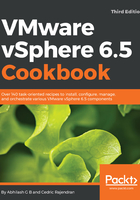
What this book covers
Chapter 1, Upgrading to vSphere 6.5, will teach you how to upgrade your existing environment to the vSphere 6.5, and you will also learn how to migrate vCenter running on Windows to appliance.
Chapter 2, Greenfield Deployment of vSphere 6.5, will show you how to perform a fresh deployment of VCSA 6.5 and installation of ESXi 6.5. You will also learn how to deploy External Platform Services Controller.
Chapter 3, Using vSphere Host Profiles, will show you how to use Host Profiles to push a configuration change, performing host customizations, remediating noncompliant hosts. You will also learn how to copy settings between host profiles.
Chapter 4, Using ESXi Image Builder, you will learn how to use ESXi Image Builder using both the new vSphere Web Client GUI and CLI. You will learn how to create image profiles from either an existing image profile and fresh profile from scratch.
Chapter 5, Using vSphere Auto Deploy, you will learn how to deploy stateless and stateful ESXi host without the need to have to run the ISO installation on the server hardware.
Chapter 6, Using vSphere Standard Switches, you will learn how to set up vSphere Networking using the standard Switches.
Chapter 7, Using vSphere Distributed Switches, will teach you how to set up vSphere Networking using vSphere Distributed Switches. You will also learn how to migrate networking from standard vSwitches to the Distributed Switches. You will also learn configuring advanced features, such as NetFlow, Port Mirroring, and Private VLANs.
Chapter 8, Creating and Managing VMFS Datastore, will show how to create VMFS Datastores.
Chapter 9, Managing Access to the iSCSI and NFS Storage, will show how to configure and manage access to the iSCSI and NFS storage.
Chapter 10, Storage IO Control, Storage DRS, and Profile-Driven Storage, will show methods to consume storage resource effectively, by controlling queue depths, reacting space and latency thresholds, and automating the usage of tiered storage.
Chapter 11, Creating and Managing Virtual Machines, will teach how to create virtual machines, configure its settings, create and manage templates, and also export them to OVFs. You will also learn how to create content libraries.
Chapter 12, Configuring vSphere 6.5 High Availability, will discuss how to configure High Availability on a cluster on ESXi hosts. You will also learn how to configure native high availability for vCenter Servers.
Chapter 13, Configuring vSphere DRS, DPM, and VMware EVC, will discuss how to pool compute resources from a cluster of ESXi hosts to enable efficient virtual machine placement and automate mitigation of resource imbalance in a cluster. You will also learn how to reduce power consumption of a cluster by changing the power state of underutilized hosts.
Chapter 14, Upgrading and Patching using vSphere Update Manager, will teach how to manage the life cycle of ESXi Hosts by patching and updating the environment.
Chapter 15, Using vSphere Certificate Manager Utility, will show how to generate certificate signing requests and replace certificates for a vSphere Environment.
Chapter 16, Using vSphere Management Assistant, will show how to deploy and configure vMA to run commands/scripts remotely on ESXi.
Chapter 17, Performance Monitoring in a vSphere Environment, will describe how to use esxtop and vCenter Performance Graphs to monitor the performance of a vSphere environment.